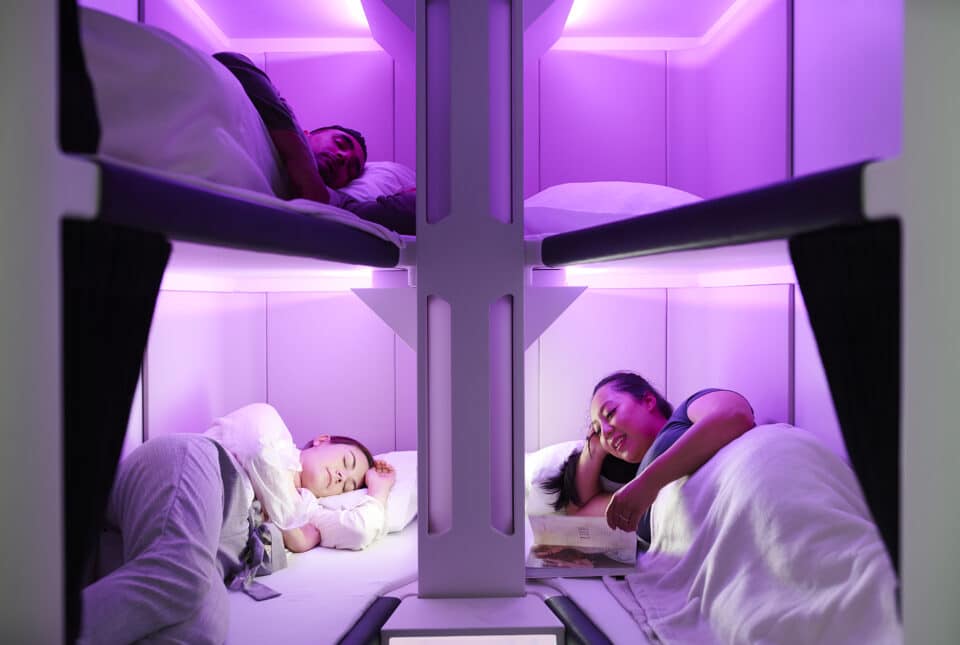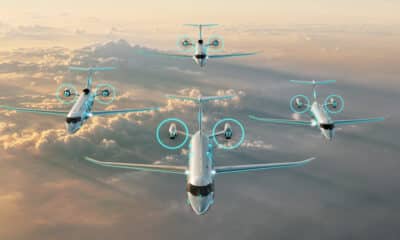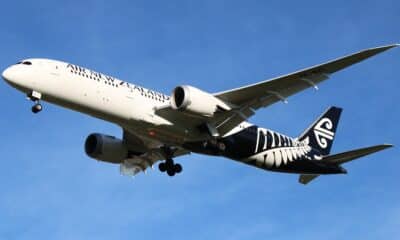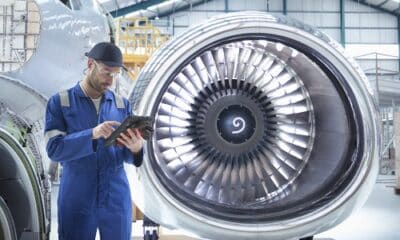Aerospace
Air New Zealand offers best sleep in the sky as it unveils new cabins

From 2024, Air New Zealand will offer a new Business Premier Luxe suite, a new Business Premier seat and the world’s first Skynest. It will offer the most choice of any airline in its three cabins to get the best sleep in the sky.
The airline has responded to overwhelming customer feedback on the importance of sleep and need for more comfort and space. The interior design is inspired by the uniqueness of Aotearoa so customers will experience New Zealand as soon as they step onboard.
Air New Zealand’s new Dreamliners, due to arrive in 2024, will give customers more choice than any airline in the world, providing the best sleep in the sky regardless of the cabin customers choose to fly in.
This includes a new Business Premier Luxe seat, designed for customers looking for more space and privacy, and Skynest, the world’s first sleep pods in the sky for Economy travellers.
Feedback from extensive customer research over five years has highlighted the importance for a good night’s sleep and the need for more space and comfort, so the new experience is designed around creating a home away from home that leaves customers refreshed and raring to go at their destination.
Air New Zealand Chief Executive Officer Greg Foran points to the airline’s ambition to create the greatest flying experience and says the new cabin, combined with world-leading Kiwi hospitality, is the winning formula.
Economy
An enhanced economy seat designed with more storage, comfort and space and a 50% bigger screen for entertainment. Connect to Bluetooth audio and pair your device to act as a remote control or second screen pic.twitter.com/WDdDUMLxN4
— Air New Zealand ✈️ (@FlyAirNZ) June 28, 2022
“New Zealand’s location puts us in a unique position to lead on the ultra-longhaul travel experience. We have zeroed in on sleep, comfort, and wellness because we know how important it is for our customers to arrive well-rested. Whether they are heading straight into a meeting, or to their first holiday hotspot – they want to hit the ground running.
“It’s a proud moment to finally unveil five years of hard mahi, in what truly is a cabin of possibility. One that will provide customers with options to get some shut eye wherever they’re sitting.”
Innovation has driven the new cabin experience from nose to tail. For Economy customers, the Skynest concept, first announced in 2020, will be a world-first.
“We wanted to offer our Economy customers a lie-flat option and that’s how Skynest was born. It’s going to be a real game changer for the economy travel experience.”
Chief Customer and Sales Officer Leanne Geraghty says the cabin’s interior design is inspired by the uniqueness of Aotearoa, from the forest inspired carpet to the seats that draw inspiration from New Zealand’s native bird, the Tui.
“Whether we are welcoming visitors or flying New Zealanders home, we want our customers to experience Aotearoa from the moment they step onboard – and get the best night’s rest.
“Research shows us the first night away from home is the hardest to get a good night’s sleep so everything we do onboard is to help create a sense of calm – from the lighting and sleep ritual including sleepy teas and balms, to the healthier food choices and breathable fabrics. Meditative onscreen content, Zentertainment, will also help customers unwind and get ready for rest.
The airline has also added a Sky Pantry to the Premium Economy and Economy cabins, so customers can stretch their legs, grab a bite to eat and hydrate at their leisure throughout their journey.
“Our new cabin experience is set to be world class, and we know our customers will love it.”
Sustainability has been at the heart of the design process. Using modern fabrics, rather than leather, has saved around one kilogram in weight per Business Premier and Premium Economy seat, reducing overall carbon emissions. In Premium cabins, the airline will also switch to serviceware that is 20% lighter, helping to reduce carbon emissions, and in Economy, the new serviceware will reduce plastic dishes used inflight by 28 million every year.
More : click

Aerospace
Which is bigger 777x or 787 aircraft ?

The 777X is a new series of the Boeing 777 family and is designed to be larger and more efficient than its predecessor. It features two variants: the 777-8 and the 777-9, being the larger of the two.
The Boeing 777X emerges as the larger sibling within the Boeing family, representing a significant leap forward in both size and efficiency. Comprising two variants, the 777-8 and the 777-9, the latter takes the crown as the larger of the two. With its expansive fuselage and impressive wingspan, the 777X is tailored for long-range journeys and boasts a substantial passenger capacity.
On the other hand, the Boeing 787, affectionately known as the Dreamliner, occupies a niche in the market as a smaller yet formidable aircraft designed for medium to long-range flights. Its distinguishing feature lies in its composite fuselage, a technological marvel that renders it lighter and more fuel-efficient compared to conventional aluminum counterparts. The Boeing 777X is larger than the Boeing 787 aircraft.
When it comes to passenger capacity, the 777-9 reigns supreme, typically accommodating a sizeable contingent of 400-425 passengers in its standard configuration. In contrast, the 787, with its more modest dimensions, typically carries between 240-290 passengers, depending on the variant and layout.
One of the remarkable innovations introduced with the 777X is its folding wingtips, a feature designed to address the logistical challenges of accommodating such a large aircraft in conventional airport gates. These folding wingtips enable the 777X to retract its wings, allowing it to fit into gates designed for smaller aircraft while still reaping the benefits of an extended wingspan during flight, thereby enhancing fuel efficiency and operational flexibility
Aerospace
China Secures Production Certificate for Mass Production of Pilotless eVTOL Aircraft

The first passenger-carrying pilotless electric vertical takeoff and landing (eVTOL) aircraft in the world, the EH216-S, has received the Production Certificate for its eVTOL aircraft from the Civil Aviation Administration of China (CAAC).
This is a significant milestone for EHang Holdings Limited, the leading UAM technology platform company in the world. This outstanding accomplishment is another big step towards mass manufacturing for the eVTOL aircraft and the ensuing commercial operations, building on the ground-breaking acquisition of the Type Certificate and the Standard Airworthiness Certificate for the EH216-S.
The PC is a crucial certificate that the aircraft maker receives from the CAAC, the country’s aviation authority. By obtaining this certificate, EHang has demonstrated that it has set up a quality management system for mass production that satisfies the airworthiness regulation standards set forth by the CAAC, and the company has been given permission to continue producing mass quantities.
It is also a strong guarantee of the calibre of the goods made by EHang. Raw materials, supplier management, manufacturing organisation, production quality control, aircraft pre-delivery test, after-sales repair and maintenance, etc. are all included in the mass production quality management system for the EH216-S.
To ensure that every aircraft and its components that roll off the production line strictly adhere to the approved type design and safety requirements, the system sets clear guidelines and documentation for every step in the production procedure. This ensures comprehensive traceability and safety control.
Aerospace
Four Airbus A380 Superjumbos lined up to be scrapped

In a strategic move aimed at reclaiming valuable resources from the iconic Airbus A380 aircraft, VAS Aero Services and Dr. Peters Group have announced a significant collaboration.
This partnership marks a milestone in aviation logistics and aftermarket services, with four of these colossal planes slated for teardown and redistribution of used serviceable material (USM).
The venture between VAS Aero Services, renowned for its expertise in aircraft dismantlement, and Dr. Peters Group, a prominent Germany-based investment fund management firm, underscores a commitment to sustainable aviation practices. This isn’t their first foray into scrapping A380s; their successful partnership has already seen the dismantlement of these aircraft, making them pioneers in this niche.
Under the agreement, the latest consignment brings the tally to eight A380s entrusted to VAS by Dr. Peters Group. Managing Director Christian Mailly of Dr. Peters Group emphasized the trust placed in VAS, citing their unparalleled capabilities in dismantlement and aftermarket sales network. It’s a strategic move in response to the growing demand for quality USM parts, particularly with the resurgence in reliance on the A380.
Notably, the teardown process will be carried out at various locations, optimizing the positioning of harvested parts to cater to different markets. While some parts will be positioned in Europe to support operators in the region and the Middle East, others will remain in the Asia-Pacific region. This meticulous strategy ensures efficient access to spare parts, benefiting MROs and airlines across these markets.
The decision to retire these A380s comes at a time when operators are reassessing fleet strategies amidst evolving market dynamics. Despite initial plans for quick retirement due to the emergence of more fuel-efficient alternatives, factors such as a rebound in long-haul demand and delays in new widebody deliveries have prompted operators to reconsider. The A380, with its unique capacity and capabilities, presents a practical solution for short-term capacity management.



























